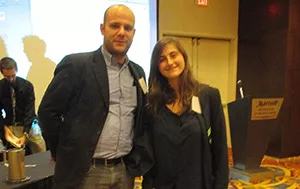Natalia Sucher '16 Presents Her Research at National Classics Conference

“Her paper was an enormous success,” says Jeremy Lefkowitz, assistant professor of classics. “I was still receiving emails of praise for her for a week later.”
Last fall, Natalia Sucher ’16 and her Classical Mythology classmates were asked to reach into a hat and pick a slip of paper corresponding to a work of art for them to explore. Sucher got Cy Twombly’s Fifty Days at Iliam, and the series of paintings, a permanent feature of the Philadelphia Museum of Art, “blew [her] away.”
That sparked a year-long examination into the connections between the paintings, Homer’s Iliad, and Alexander Pope’s translation of Homer, culminating in Sucher’s presentation to the annual meeting of The Classical Association of the Atlantic States (CAAS) in Washington, D.C. in mid-October.
She argued that while Twombly’s work can be very difficult to decipher, it explores themes that are central to Homer’s Greek.
“Her paper was an enormous success,” says Jeremy Lefkowitz, assistant professor of classics, who also attended the conference along with Rosaria Munson, J. Archer and Helen C. Turner Professor of Classics. “I was still receiving e-mails of praise for her for a week later.”
CAAS leaders thought so much of the presentation that they encouraged Sucher to apply for a $10,000 fellowship at the American School of Classical Studies in Athens this summer. Sucher is applying for the fellowship, with the hopes of making new discoveries.
She spent the first two days of the conference soaking up its classical scholarship. When it was her turn to present “Force, Motion, and Tradition in Cy Twombly’s Fifty Days At Iliam,” her nerves and excitement swelled.
“But I channeled my feelings into the enthusiasm I felt for the topic,” says Sucher, an honors Greek and Latin major from Brooklyn, N.Y.
“What I found so captivating about the works was that the concepts of chaos and order, life and death, emergence and convergence applied not only to the characters but also the universe itself,” she adds. “Each work illuminates different concepts about the others and themselves.”
Sucher’s enthusiasm was so evident to Lefkowitz last fall that he urged her to delve into the topic in her intermediate Greek course.
“Her initial paper was bursting with ideas and interpretations of Twombly’s work,” he said. “It was clear that she had an uncanny ability to see meaning where others saw only abstraction and confusion.”
In March, Lefkowitz suggested sending an abstract of the worked-up paper to CAAS, and he and Sucher collaborated on several drafts before it was accepted. The work on the paper continued over the summer and Associate Professor of Classics and Philosophy Grace Ledbetter advised Sucher on preparing a presentation.
“Museum-goers tend to have polarized reactions to the Twombly installation: they are intrigued or they are baffled,” says Ledbetter. “Natalia’s paper not only helps us to understand how Twombly reads the Iliad, but it also sheds light on aspects of the original poem that Classicists have not always emphasized.”
Sucher became the second Classics student to present at a national conference while at Swarthmore — an opportunity that is not easy to come by in the humanities, says Lefkowitz. She follows Amanda Klause '12, who presented at the 2011 CAAS and is now pursuing a Ph.D. in Classics at Princeton.
“I find it extremely gratifying to work with students on original research projects,” says Lefkowitz. “It was a thrill to watch Natalia’s paper evolve from its original form into such a polished and persuasive oral presentation.”



